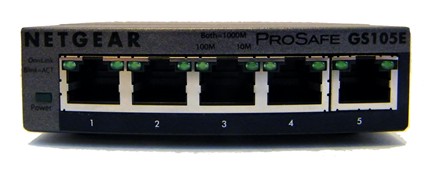By Sean Michael Kerner
Tucked away in many offices and home deployments are small, five-port, unmanaged desktop switches that work away tirelessly without any user interaction. If you’re starting to think about power usage for your network, you might want to take a look at those switches.
Not all small networking switches are the same. A new generation of small gigabit switches is now available to consumers claiming to provide “green” benefits. These green switches are supposed to use less power than their less enlightened predecessors of years past. How much less power? As it turns out, based on our tests: Quite a bit.
There are a number of different vendors and switches that make “green” claims. This review examines two such switches from D-Link and Netgear. Both switches are five-port, unmanaged, gigabit Ethernet switches.
For purposes of comparison, an older, non-green-marketed, five-port unmanaged gigabit Ethernet switch from Linksys is being included in the power testing evaluation. The Linksys switch used is similar to the one reviewed five years ago by PracticallyNetworked.com: a first-generation five port gigabit switch from Linksys.
D-Link DGS 2205

The D-Link DGS 2205 is a small device measuring only 5.81″ wide x 4.45″ high x 1.24″ deep. The included adapter is also small, making it easy to plug into UPS and power bars that are already in use.
The cable ports are at the rear of the switch, with the front of the switch providing the lighted display information. Amber and green lights identify if the port is connected to 100 Mbps or 1000 Mbps (1 Gbps) endpoints, respectively.
On device power-up, the DGS 2205 also performs a cable diagnostic which will flash a combination of LED lights on any port where there is some kind cable damage or other issue. It’s a neat idea, though the only issue I had with the cable diagnostic is the fact that it’s only available on device power-up and it’s not available once the switch is already running and active.
From a QoS perspective, the DGS 2205 supports 802.1p, so latency-sensitive traffic can be prioritized.
As a completely unmanaged device, the DGS 2205 has no configuration elements: It’s just plug and play.
Netgear GS105E

The Netgear GS105E is a smaller device than the DGS 2205, measuring only 4.1″ wide x 3.7″ high x 1.1″ deep, and weighing only 0.66 pounds. The included AC adapter is nearly identical to the one that the DGS 2205 provides.
The ports on the GS 105E are on the front of the device, which is also where the indicator lights are. One light identifies a 100 Mbps connection, while two lights indicate a 1000 Mbps connection. The only problem with the setup is that with such a small switch, when all ports are connected, it’s not as easy to actually see what’s connected as a rear port setup. That’s a personal preference, and most larger enterprise switches have front ports.
With the GS105E, Netgear is providing what it calls an “unmanaged plus” switch. Not quite a fully managed switch, but as opposed to the DGS-2205, this switch does have a number of configuration options.
Unfortunately though, the configuration options are only available by way of a Windows-only application that needs to be installed. That’s right, no Web-based interface and no access for Mac or Linux users to the configuration tool.
The configuration utility provides visibility into port status, speed and statistics monitoring (bytes sent/received and CRC Error Packet count). For the monitoring screen, it’s a static display, meaning that the data is not updated while the window is open. You need to hit refresh in order to update the stats — not a big deal but still a little annoying.
As a test, a port that was active and connected was disconnected (cable pulled out) while the configuration utility was open on the Port Status screen. Since the status is static, there was no indication that the port was no longer active until the refresh key was hit. So no, this isn’t an ideal monitoring solution on its own, but it’s still something.
Where the GS105E goes above beyond what you’d ever expect from a small (mostly) unmanaged switch is with its VLAN and QoS features. Usually VLAN isn’t something you can configure on this size (and price point) switch and the console setup for configuration is easy to figure out.
With the QoS, the GS 105E supports 802.1p just like the DGS-2205, but it goes far beyond that with the ability to set a port by port prioritization for traffic. This is a huge bonus if you’ve got an older voice terminal adapter, IP phone or even just a Skype endpoint where you want to ensure traffic prioritization and low latency. No, it’s not a total replacement for having proper bandwidth shaping across your network, but it’s a solid step and one that’s great to have at the last hop switch.
Additionally there are Rate Limiting and Broadcast Filtering configuration options so you can effectively try to control bandwidth for the connected ports. Again these are features that typically aren’t seen on small switches, but can make a big difference to network quality. With Rate Limiting, speed to a particular port can be limited while Broadcast filtering is an attempt to mitigate packet floods and potential Denial of Service (DoS) conditions.
Power Usage Testing
Both the DGS-2205 and the GS105E are marketed as “green” switches. Both devices are supposed to use less power by not delivering ‘always on’ power to ports that aren’t active or connected. D-Link’s packaging states that the DGS-2205 provides up to 73 percent power saving when compared to a conventional D-Link switch. Netgear claims that the GS105E delivers up to 60 percent lower power consumption.
For the purposes of this review, the GS105E and the DGS-2205 were compared against a Linksys SD2005 five port gigabit conventional “non-green” switch. The test methodology involved using a blueplanet branded EM100 Electronic Energy Meter into which the tested switches were plugged.
Note: The wattage test device only reported whole units of 1 watt (w) or greater. As such, power usage of less than 1w was reported by the EM100 to be 0w, but for purposes of this review will be noted simply as ‘less than 1w.”
Each switch was connected to the same endpoints during the testing:
Port 1: 100 Mbps Windows PC with a Cat5e cable connection length of 50 feet
Port 2: 1000 Mbps Linux PC with a Cat5e cable connection length of 5 feet
Port 3: 1000 Mbps Linux NAS with a Cat5e cable connection length of 5 feet
Port 4: 1000 Mbps Windows PC with a Cat5e connection length of 5 feet
Port 5: 100 Mbps uplink to Router. Connected via a 1-foot Cat5 cable.
Idle Test
With no ports physically connected, the SD2005 drew 5 watts (w) of power.
In contrast both the DGS-2005 and GS105E required less than 1w of power when idle with no physically connected ports.
All Ports Connected, Regular Traffic
With all five ports connected to the test network running regular everyday production traffic (a mix of VoIP, web TCP/IP and SMB/CIFS during normal, everyday usage) the SD2005 pulled an average of 9w of power. The GS105E on average drew 2w of power, while the DGS2205 on average required less than 1w of power.
Three Ports Connected, Regular Traffic
With all five ports physically connected, two endpoints physically turned off (i.e. PC’s not on) and just Ports 3,4 and 5 active, the SD2005 continued to draw 9w (the same as when all five ports were active). In contrast, the GS105E on average used less then 1w as did the DGS-2205.
All Ports Connected, iperf
The open source application iperf (and JPerf UI) provides a network performance measurement tool that can also be used to help load traffic. Running one port as the iperf server (where traffic is directed inbound) and two ports with 40 concurrent streams each with a TCP window size of 8 KB, there was no difference on any of the tested switches in terms of wattage used vs. average everyday usage. (Not too surprising, since power utilization is based mostly powering the port itself and the length of cable, not on bandwidth — though the bandwidth is what keeps the ports open/active.)
Conclusions
Bottom line is that with the switches we tested, “green” isn’t just a marketing ploy. With both the DGS-2205 and the GS105E, there was a significant difference in power used over a traditional “non-green” switch. Part of that power reduction starts at the top with idle, non-connected usage and it extends to how the two switches deal with connected ports and their associated activity.
From a features perspective, it’s not really fair to directly compare the DGS-2205 against the GS105E, even though both are five port unmanaged gigabit Ethernet switches. The unmanaged “plus” capabilities that Netgear packs in to the GS105E provide some real power to network administration and control that regular unmanaged devices don’t deliver. Netgear also has a GS105 switch that does not include the extra QoS and VLAN capabilities of the GS105E.
D-Link’s DGS-2205 is as simple as networking gets, you just plug your cables in and it works, flawlessly.
If you’re looking to add a new gigabit switch for small workgroup needs, it makes sense to add one that is power-friendly. Sure the total amount of watts used overall is still quite small, but every watt does count after all.
Buyer Information
D-Link DGS2205
MSRP: $42.99
Pros: energy saving, 802.1p support for QoS
Cons: cable diagnostic only available at switch start
Netgear GS105E
MSRP: $69.99
Pros: energy saving, configurable QoS, VLAN management
Cons: admin utility is Windows-only, monitoring window is static



